My Pilgrimage Ride on the Camino de Santiago
Camino de Santiago is a popular network of pilgrimages leading to the shrine of the apostle St. James in a cathedral in northwest Spain.
By Steven Lowe
When my wife expressed an interest in doing the Camino de Santiago pilgrimage I had no idea what it was. I soon found out that Camino de Santiago or The Way of St. James is a well-traveled network of pilgrimages leading to the shrine of the apostle St. James in the cathedral of Santiago de Compostela in Galicia in northwest Spain. Our original plan was to do the Camino Portuguese or the Portuguese way from Porto. But due to the pandemic we thought in would be easier to stay in Spain since it would more inconvenient to cross borders with our seven-year-old unvaccinated son.


We did the most popular route called the Camino Frances (the French Way), which typically starts on the French side of the border in the Pyrenees and could take a month of hiking to complete. Since we didn’t have the time to complete the whole route, we decided to start in Sarria and do the last 117km of this journey. My wife’s goal was to earn the certificate of completion, which requires at least 100km of hiking (200km by bike). My goal was to experience the journey, so my seven-year-old son and I biked the route while my wife hiked it. By the way, you can complete the journey in multiple segments or several trips so you don’t need to do it all in one trip to receive the certificate of completion. In order to document the trip you do need an official Camino passport and need to get it stamped at least twice a day. You can get it stamped along the way at your lodging, cafes, restaurants, churches, etc.
I know many of you are wondering if it’s currently a good time to go to Spain or do the pilgrimage journey. The answer is that’s a great time to do this and it was easy to get to Spain if you’re fully vaccinated. There’s no quarantine when you get to Spain. This situation might change but as of this writing it’s safe and easy to go to Spain. In fact it currently has over 75% fully vaccinated rate. The goal is to hit 90% by December.
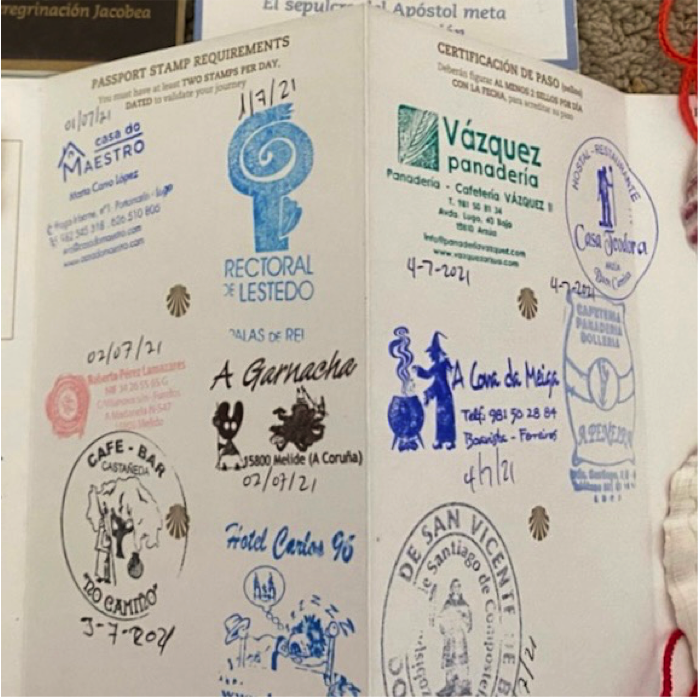

Another reason why it’s a great time to go is because there are very few (compared to a normal year) pilgrims doing all of the routes. A lodging manager along the Frances route told me that typically that there are about 2,000 pilgrims per day and currently there are about 200. At the finish on a typical year, in order to obtain the certificate of completion one must wait for hours. My wife waited about 20 minutes. If there’s a negative, it’s that about 20 percent or more of businesses that cater to pilgrims (lodging, restaurants, etc) are temporarily closed. But we never had problems finding places to eat nor places to stay. Google Maps can be inaccurate, indicating open businesses when in reality they’re closed.
Before I started the pilgrimage, I shipped my folding bike (in it’s own special hard luggage) a week prior to the starting city Sarria for only 30 euros. It’s cheaper than checking the luggage onto the plane. I was planning to pick up my bike at Sarria’s post office but the hotel manager was nice enough to pick it up for me so my bike was waiting for me at the hotel. That was just the start of local hospitality.
Sarria is the most populous town located along the French Way and is a popular starting point for the Camino de Santiago. We decided stay in hotels along this journey as opposed to the popular albergues (hostels). We basically chose comfort over cost and comradery.
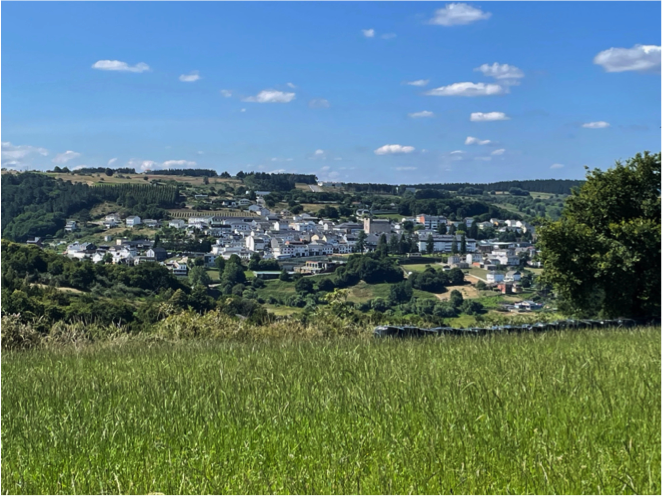

Day 1 – Sarria – Portomarin – (15 miles)
The first day of riding was pretty much me getting used to my bike with all the gear and getting used to the rigours ahead. Although I had studied the route prior to to the trip, I felt like everything I was experiencing in person was new and exciting. As I rode I soaked up my surroundings with wide-eyed curiosity. With so few pilgrims on the road it was also an introspective experience. With the sounds of the wind rushing by, bike tires bouncing on cobblestone roads, birds chirping … it had a meditative quality with the rhythms of the journey broken by my conversations with my son. As we passed by rolled hay bales, it reminded me of paintings done by Impressionist painters in the 1800s. Riding my folding bike fully loaded was also a new experience for me. I had been riding for months on it prior to the trip unloaded but with all the extra weight on it, it felt like a completely different steed. Without the weight of the panniers the steering was a bit more sensitive than full-sized bikes. The front-heavy weight helped calm the nervous steering.
As we rode through lush greenery, Portomarin loomed ahead like an oasis with its white buildings standing out. Having to cross the tall, narrow bridge to get into town gave it a “Lord of the Rings” feel. I didn’t see it but there’s supposed to be a Roman-era bridge located somewhere below the current modern bridge. The hotel we stayed in, Casa do Maestro, was fabulous with great service and secure bike parking, a hand-wash laundry area and excellent breakfast and all-day coffee, tea and snacks. We seemingly had the run of the hotel.
Portomarin is a small town of just under 2,000 people (and decreasing) located along the Camino route next to the Mino river. The original town was located on the lower banks prior to being flooded when the river was damed in the 1960s. Most of the older buildings were moved to the current higher ground. It only takes about 20 minutes to explore the whole town.
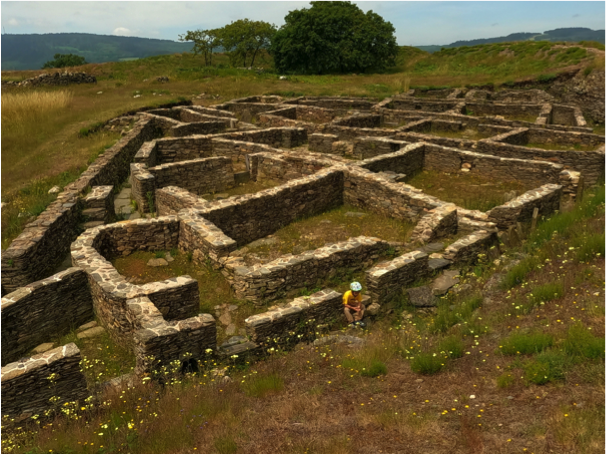

Day 2: Portomarin – Lestedo (14 miles)
Today was a bit of an uncertainty. It would be nice if we could make it to the town of Palas de Rei for the night, but that would be too much of a hike for my wife (about 15+ miles) so we decided to look for lodging just before that town. We settled on a gem called Rectoral de Lestedo. It’s listed as a rural hotel and even has accommodations for horses nearby (I believe). This amazing small hotel turned out to be the best lodging on this journey. This place had tons of charm, history, and of course wonderful food (Brazilian chef). It used to be a rectory where priests stayed. I highly recommend everyone to stay here or at least stop for a meal.
The highlight of the day was a stop at the pre-Roman archeological site near the village of Castromalor. This amazing ruin is located on top of a strategic hill with great views. It was puzzling that no other pilgrims stopped to visit this site even though it’s located just off the Camino trail. Although I wanted to experience the pilgrimage journey and explore what it has to offer, I suppose others are more focused on getting from point A to B. I also noticed that villages and (open) cafes were spaced out farther on this day, so my son and I were a bit short on water and food at times. Fortunately we happened on a cafe in the middle of nowhere but thankfully right on the Camino trail. As you can see in the photos above the cafe isn’t very busy. I can only imagine on a normal year when most of the tables are busy with tired and hungry pilgrims.
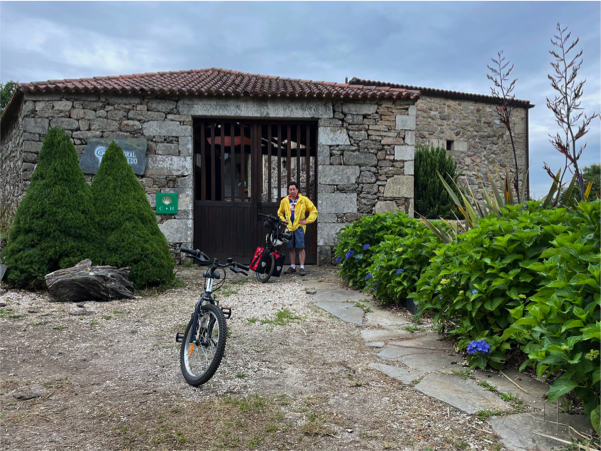

Day 3: Lestedo – Melide (10 miles)
We left Rectoral de Lestedo wishing we could spend another night. On this day it started to sprinkle when we left and I had to adjust my son’s (bicycle) rear derailer, which foreshadowed what was to come. The sprinkle slowly turned into rain and we finally had to take cover under a sheltered bus stop. After waiting a while with no letup, I finally asked my son whether he wanted to continue to wait for the rain to die down or continue the ride. He bravely said he wanted to ride. So we rode this time on the busy two-lane road with narrow sides. This turned out to be quite harrowing because of the rain, heavy (fast) traffic and lots of big trucks. Fortunately, Spanish drivers were quite careful when driving by us. They tended to give us a wide berth when possible, unlike in the US. We didn’t ride on the dirt trails when it was raining hard. This was a day that I will remember for a long time. What a relief when we got to our next destination of Melide. After cleaning and resting, I decided to explore the town. Since I wasn’t staying in the centre of town it seemed oddly quiet and nondescript. Many of the businesses were closed with few interesting food options. Fortunately I found one of the Pulperias (octopus specialty restaurants) that this town was famous for. After dinner we went to the nearby cafe so my son could have his (daily) desert. That’s when I bumped into another fine Galician tradition where they continuously serve trays of tasty morsels to all customers seemingly every five minutes. I could get used to this tradition.
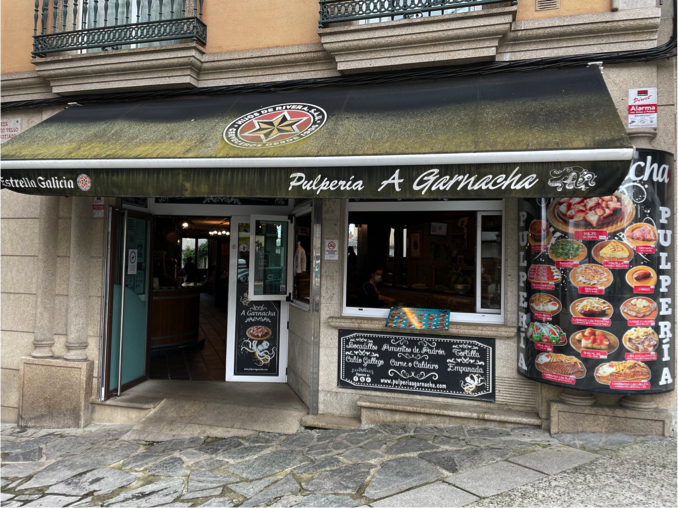

Day 4: Melide – Arzua (10+ miles)
We started out the day going towards the centre of Melide. It was a relatively easy ride towards Arzua as we rode past small villages, woods, and on dirt and paved paths. We started to see more pilgrims. It might have to do with Melide as a crossroads where the Northern route meets the French route. This day’s journey was beautiful and best of all it didn’t rain. After a few days of riding (or walking) your body will get used to the rigours of the journey.
My son and I arrived at Arzua with plenty of time to explore the town before my wife arrived. Oddly enough this was the first town we found a masseuse… which we tried out. I would think this would be a great business to have all along the pilgrimage routes.
After talking to the local tourist booth located next to our hotel Pension Casa Teodora, I found the best meal we had on this pilgrimage. We had dinner at Casa Nene. It’s a nouveau Galician restaurant meaning it serves modern Galician dishes or they do a modern take on traditional Galician dishes. They also served the best vermouth we had on our trip called St Petroni (red). It’s a sophisticated, slightly bitter Galician vermouth—light years away from the common sweet Martini vermouth.
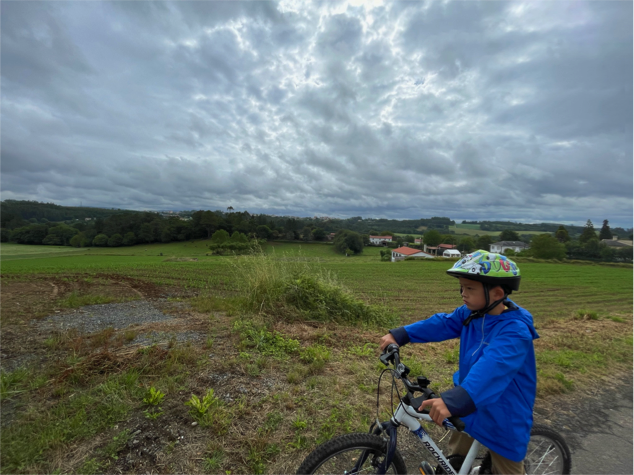

Day 5: Arzua – Pedrouzo (15 miles)
This day’s ride was longer not only in distance but also in the time it took to complete, and it sprinkled off and on throughout the day. Two-thirds of the way into the ride, my son’s bike developed a slow leak, which I had to constantly pump up due to the lack of correct tools to repair it. With only a few miles left I wasn’t sure we would be able to finish the day as the leak became more persistent. This being a Sunday almost all businesses were closed other than a few restaurants and bars. In addition we were riding in the rural countryside. We finally reached an intersection in the middle of nowhere with three bars/cafes. I went into each asking an employee for a wrench to fix my son’s bike to no avail. Finally a patron (Miguel) at one asked in perfect English what the problem was and then shortly thereafter drove home to pick up a wrench!
The friendliness and generosity of locals during this journey never failed to surprise me. Miguel basically turned what could have been the most challenging day of the trip into the best day. As payback I offered to buy him a beer (and a second… and third) and we joined him at the bar chit-chatting about various topics. Long story short, my wife reached our lodging before I did. This evening was the first that we stayed at a hostel. It looked more like a converted former estate and did the job admirably. Interestingly, although there were other’s staying here we never really saw anyone else in person. Pedrouzo seemed somewhat like a ghost town with only few lodging and food options open for business. Google Maps as usual wasn’t dependable in letting me know what was open or closed. Fortunately dinner at Parrillada just across the street from the hostel did the job and we were almost the only customers there.
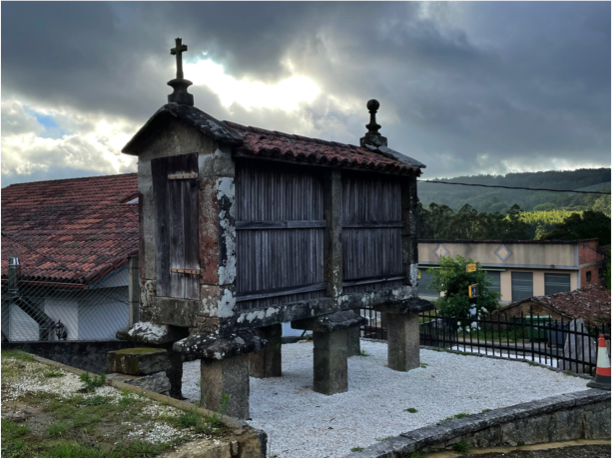

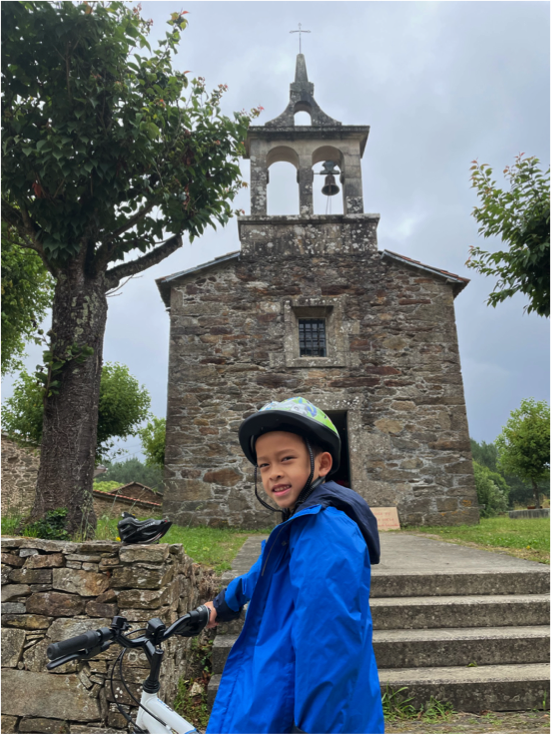

Day 6: Pedrouzo – Santiago de Compostela (16 miles)
The final day on the saddle was wet and cloudy but the anticipation of completing the trip made all the challenges melt away. The number of pilgrims along the path grew as my son and I edged closer to Santiago de Compostela. Once we reached the city sign on the city outskirts I didn’t realise it still took awhile to get to the old town and cathedral. With the hustle and bustle of the city it really struck me as to the difference the past few days being in the rural countryside compared to being back in civilisation. This was especially true when my son and I hit some major construction areas. Once we reached the cathedral plaza, I saw other pilgrims snapping selfies, some taking photos of the bare raised feet with the church as the background. The old town with its maze of streets is well worth spending a day or two to explore. Our celebratory dinner was at restaurante Casa Camilo where we gorged ourselves with seafood and libations.
Epilogue
After completing our journey, my family enjoyed the trip so much that we are thinking of doing a different route in the future, maybe the Portuguese route. If not to complete another route, at least do parts of it. The journey itself is so enjoyable (and well marked and organized) that it seems fitting to do it again. On a different note future trip ideas can be other parts of Europe, Asia (Japan, Vietnam or Thailand). If you have any questions or are interested in joining me in the future, feel free to drop me a line. I’ve also edited a video of this trip and posted it on my Youtube channel.
For more, visit Travelin’ Traveler, Steven Lowe’s travel page.







Leave a Reply